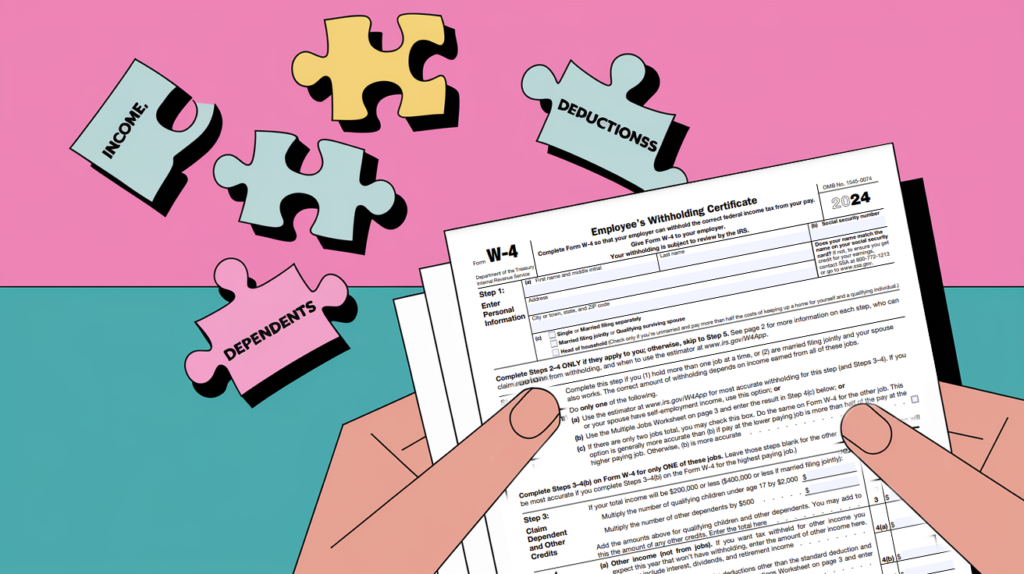At XOA TAX, we often get questions about Form W-4 and how to fill it out correctly. It’s an important form because it determines how much federal income tax your employer withholds from your paycheck. Getting it right can save you a headache come tax time! Let’s break down the W-4 and why it matters, especially for the 2024 tax year.
Key Takeaways:
- While you don’t need to fill out a new W-4 every year, the IRS recommends reviewing it annually, especially if your tax situation has changed or you had a large tax bill or refund last year.
- Accurate completion of your W-4 ensures you have the right amount of tax withheld from your paychecks throughout 2024.
- The IRS provides resources to help you determine your correct withholding, including the Tax Withholding Estimator.
What is Form W-4?
Think of Form W-4, officially titled “Employee’s Withholding Certificate,” as your instruction manual for your employer. It tells them exactly how much federal income tax to deduct from each paycheck. You fill it out when you start a new job, but it’s not a “set it and forget it” kind of thing. You might need to update it throughout the year if your personal or financial situation changes.
When Should You Update Your W-4 in 2024?
Life throws curveballs, and some of those curveballs can impact your taxes! Here are some common situations that might require a W-4 update:
- Changes in marital status: Getting married or divorced can significantly impact your tax bracket and deductions.
- Growing your family: Welcoming a child or adopting means you might be eligible for tax credits that can affect your withholding.
- Taking on a side hustle: If you start a second job or pick up freelance work, you’ll need to adjust your withholding to account for the extra income.
- Getting a raise (congratulations!): A significant increase in income may necessitate a change in your withholding to avoid a surprise tax bill.
- Big financial moves: Buying a home or making other major financial decisions that impact your deductions can also affect your W-4.
How to Fill Out Form W-4 for 2024
Always use the most recent version of Form W-4 found on the IRS website (www.irs.gov). Here’s a general overview of the steps involved:
Step 1: Personal Information
Provide your name, address, Social Security number, and filing status.
Step 2: Multiple Jobs or Spouse Works
This section helps you accurately calculate withholding if you have multiple jobs or if your spouse also works. The form provides options and worksheets to guide you through this process.
Step 3: Claim Dependents
You can claim dependents, such as children, to adjust your withholding. For 2024, the Child Tax Credit is up to $2,000 per qualifying child under 17. Eligibility for the full credit begins to phase out at $200,000 for single filers and $400,000 for married filing jointly.
Step 4: Other Adjustments (Optional)
This section allows you to make additional adjustments to your withholding if needed. You can choose to have more tax withheld or account for other deductions you plan to claim. You can also specify a different withholding rate for supplemental wages like bonuses. For supplemental wages (bonuses, commissions, etc.), the standard withholding rate is 22% for amounts up to $1 million and 37% for amounts above that threshold.
Step 5: Sign and Date
Sign and date your completed W-4. Many employers now offer electronic W-4 systems for convenient online submission.
Tips for Accurate Withholding in 2024
- Use the IRS Tax Withholding Estimator: This online tool can help you determine if your current withholding is appropriate. To use the estimator, you’ll need information like your latest pay stub, a copy of your most recent tax return, and details about any other income or deductions.
- Review your withholding after major life changes: Keep your W-4 up-to-date to avoid owing taxes or having too much withheld.
- Remember that withholding calculations are based on your projected annual income: If you expect your income to change significantly throughout the year, adjust your W-4 accordingly.
- Aim for sufficient withholding to avoid penalties: Generally, you need to withhold at least 90% of your current year’s tax liability or 100% of your previous year’s tax liability to avoid penalties.
- Consult a tax professional: If you have complex tax situations or need personalized advice, consider seeking assistance from a qualified tax professional.
Key Dates for 2024 Withholding
- January 1, 2024: New W-4 takes effect for the tax year.
- December 31, 2024: Deadline for making any final withholding adjustments for the tax year.
- January 31, 2025: Deadline for employers to provide W-2 forms for 2024.
Record Keeping Tip:
Keep a copy of your submitted W-4 and any calculations or worksheets you used to determine your withholding. This documentation can be helpful if questions arise about your withholding elections.
Example Scenario:
Sarah gets married in June 2024, and her spouse also works. She should submit a new W-4 to reflect her changed filing status and use Step 2 to account for having two working spouses, ensuring sufficient withholding for their combined income.
Pro Tip:
Consider reviewing your withholding around June or July to ensure you’re on track. This mid-year check can help you identify and correct any withholding issues before they become significant.
Understanding the Difference: W-4 vs. W-2
- Form W-4: Instructs your employer on how much tax to withhold from your wages.
- Form W-2: Reports your annual wages and the amount of tax withheld from your pay. You receive this form from your employer at the end of the year for tax filing purposes.
State Withholding
Some states have their own withholding forms and requirements. Check with your state’s tax agency for more information.
By understanding Form W-4 and keeping your withholding accurate, you can ensure a smoother tax season and avoid surprises when you file your return.
For the most current and complete information, always refer to IRS.gov.
FAQs about Form W-4
Q: Do I need to fill out a new W-4 every year?
A: Not necessarily. However, it’s a good idea to review your W-4 annually, especially if your life circumstances or income have changed.
Q: What happens if I don’t withhold enough taxes?
A: You may end up owing taxes when you file your return and could even face penalties.
Q: Can I adjust my withholding at any time?
A: Absolutely! You can submit a new W-4 to your employer whenever you need to make changes to your withholding.
Q: Where can I find more information about Form W-4?
A: The IRS website (www.irs.gov) is your go-to resource for all things tax-related, including detailed information and instructions for Form W-4.
Need Help?
We understand that navigating the ins and outs of Form W-4 and tax withholding can be tricky. That’s why , our team of experienced tax professionals can provide personalized guidance and support to help you optimize your tax situation.
- Website: https://www.xoatax.com/
- Phone: +1 (714) 594-6986
- Email: [email protected]
- Contact Page: https://www.xoatax.com/contact-us/
Disclaimer: This post is intended for informational purposes only and does not constitute legal, tax, or financial advice. Please be aware that laws, regulations, and tax rates are subject to frequent changes. Readers are encouraged to consult professional advisors to address their specific circumstances.




 anywhere
anywhere  anytime
anytime